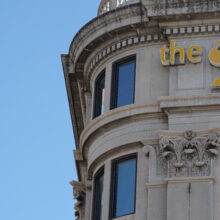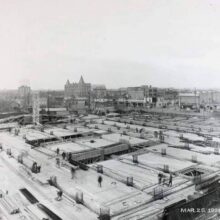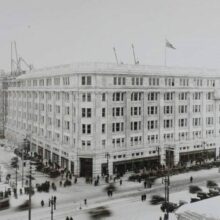Winnipeg – Hudson’s Bay Company Downtown Store
There was perhaps no better place for a shopping spree in Winnipeg than Portage Avenue in the 1920s.
Department store powerhouses such as Eaton’s and Woolworths had established themselves on the avenue in the 1920s, and had helped shape Portage Avenue as the dominant retail hub of Winnipeg. Today, though, both the Eaton’s and Woolworth buildings have been demolished – leaving only one of Winnipeg’s grand department stores still standing.
The Hudson Bay Company (HBC) was not originally a department store retailer. Founded in 1670, the HBC made their fortune off the fur trade in the Hudson Bay watershed area – establishing forts and fur trading posts across what would become Manitoba. Over the centuries, though, the fur trade would decline and to adapt the HBC would shift into newer models of retail.
By the 1870s, the HBC had opened a small trading post along Winnipeg’s Main Street, the then-retail hub in a growing prairie city. Over time, though, rising real estate costs meant newer stores were shifting further west of Main Street, to the underdeveloped Portage Avenue. Eaton’s was one such company that took advantage of the cheaper land costs, and opened up a store on Portage Avenue in 1905. Throughout the 1910s, the HBC made attempts to expand and build a new store in the area – but financial, personal, and political complications slowed the plans.
It was only in the 1920s that the HBC’s dreams for their flagship store could be fully realized. A corner lot on Memorial Boulevard and Portage Avenue was selected for the building. From the intersection, one could see directly down to the Manitoba Legislative Building, part of a grand boulevard and bigger plans for Winnipeg’s future. Montreal architects Barott and Blackadder designed the Beaux-Arts style building, which began construction in 1925. Roughly 150,000 tons of earth were moved to make room for fifteen acres of gross floor space, all for a cost of $5 million. The six-storey building largely used Manitoban construction material: steel from Selkirk, plaster from Gypsumville, and lumber taken from local trees. When it was completed, it also featured a newer innovation: electric elevators. At the time of its opening, it was the largest reinforced concrete building in Canada.
The opening of the new flagship store in 1926 garnered significant attention. At the store’s grand opening one woman, in her excitement, ducked under the arms of a police officer and became the first customer to enter the store. Stepping inside, patrons could find more than just goods – there were large murals of the company’s history, as well as library. For many years the store experienced great popularity, and steady renovations and additions took place. Among these additions would be the iconic Paddlewheel restaurant on the sixth floor, which became a staple of Winnipeg’s music scene in the 1960s. Both up and coming and established Winnipeg musicians frequented the restaurant, including Burton Cummings of The Guess Who and Neil Young.
By the 1990s, the retail business in downtown Winnipeg had begun to decline. Increased suburbanization, and the opening of more malls outside of the city’s core meant consumer traffic had shifted elsewhere. Over time, as interest dwindled, the floors of the store began to empty out, until the entire building was closed in 2020. In 2022, ownership of the building was transferred to the Southern Chiefs’ Organization, who plan to redevelop it as a mix-use space.





























